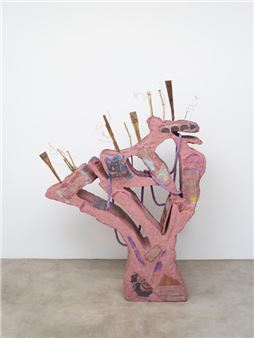Lexicon: Angela Detanico & Rafael Lain
In the 17th century German astronomer Johann Bayer created a classification for each star of each constellation in the solar system, according to their magnitude order. To the brightest stars were attributed the Greek letter Alpha, decreasing on until the Omega letter. Detanico Lain appropriated BayerÔÇÖs system to create three of this showÔÇÖs works.
Constela├º├Áes do Alfabeto (Alphabetical Constellations) comprises 24 drawings where stars of a same magnitude, according to Bayer, are joined together forming constellations. Similar procedure is found in L├®xico (Lexicon). In this case, however, words appear upon BayersÔÇÖ Greek letters sky, such as: hypothesis, harmony and idea. Those words are all of ordinary use in Portuguese and of Greek origin.
Estrelas do Sul (Southern Stars) is composed of one animation and sound. Here, constellations patterns were used as score for the sound elements and drawings. To each letter was given a sound rate. Then, the duo measured the distances between the ÔÇ£alphasÔÇØ, ÔÇ£betasÔÇØ, etc. The gap between sounds is of 1 cm per second.
In astronomy, an analemma is an image resulting from a photographic documentation of the sunÔÇÖs movement in the sky throughout a year, always regarding a specific time of the day. Analema (Analemma) is also the title of the installation where Detanico Lain repeat the trace of the sun and replace it for a sentence formed by 365 letters applied upon one the walls. The same concept reappears in Ano Solar (Solar Year) a calendar composed of 365 postcards that repeat the letters of Analema sentence and the position of the sun in the southern hemisphere.
For the Univers installation, Detanico Lain employed the Univers type font, which was developed by Swiss typographer Adrian Frutiger in 1954. According to the artists, the Univers font inflects functionalist ideas present in graphic design production of the first half of the 20th century. It was believed at the time that simplicity in typography would determine a more efficient access to the message. To those elements Detanico Lain added the Big Bang theory or the constant expansion of the universe. By gathering the typographic font and the constant expanding universe, the Univers wall painting rose, where fragments of words are painted on a black surface of one of the walls in VermelhoÔÇÖs hall 1. At the opposite wall, the artists present the word correctly configured, what suggests the constant movement of the expanding universe.
Na desordem que ├® a ordem em que as coisas acontecem (Disorder is the order in which things happen) is a piece where the functionalist sense of Univers unfolds into a muddle of letters, carved on wooden rulers. A certain alignment reveals the sentence that also entitles this work.
Twelve hours long sound piece Jardim das horas (The HoursÔÇÖ Garden) is an open icosahedron. Each of its 32 faces corresponds to a 5 seconds sound, recorded in a loop. Here, the icosahedron shape works as a clock where the clock hands determine the combination of the sound elements.

Recommended for you
In the 17th century German astronomer Johann Bayer created a classification for each star of each constellation in the solar system, according to their magnitude order. To the brightest stars were attributed the Greek letter Alpha, decreasing on until the Omega letter. Detanico Lain appropriated BayerÔÇÖs system to create three of this showÔÇÖs works.
Constela├º├Áes do Alfabeto (Alphabetical Constellations) comprises 24 drawings where stars of a same magnitude, according to Bayer, are joined together forming constellations. Similar procedure is found in L├®xico (Lexicon). In this case, however, words appear upon BayersÔÇÖ Greek letters sky, such as: hypothesis, harmony and idea. Those words are all of ordinary use in Portuguese and of Greek origin.
Estrelas do Sul (Southern Stars) is composed of one animation and sound. Here, constellations patterns were used as score for the sound elements and drawings. To each letter was given a sound rate. Then, the duo measured the distances between the ÔÇ£alphasÔÇØ, ÔÇ£betasÔÇØ, etc. The gap between sounds is of 1 cm per second.
In astronomy, an analemma is an image resulting from a photographic documentation of the sunÔÇÖs movement in the sky throughout a year, always regarding a specific time of the day. Analema (Analemma) is also the title of the installation where Detanico Lain repeat the trace of the sun and replace it for a sentence formed by 365 letters applied upon one the walls. The same concept reappears in Ano Solar (Solar Year) a calendar composed of 365 postcards that repeat the letters of Analema sentence and the position of the sun in the southern hemisphere.
For the Univers installation, Detanico Lain employed the Univers type font, which was developed by Swiss typographer Adrian Frutiger in 1954. According to the artists, the Univers font inflects functionalist ideas present in graphic design production of the first half of the 20th century. It was believed at the time that simplicity in typography would determine a more efficient access to the message. To those elements Detanico Lain added the Big Bang theory or the constant expansion of the universe. By gathering the typographic font and the constant expanding universe, the Univers wall painting rose, where fragments of words are painted on a black surface of one of the walls in VermelhoÔÇÖs hall 1. At the opposite wall, the artists present the word correctly configured, what suggests the constant movement of the expanding universe.
Na desordem que ├® a ordem em que as coisas acontecem (Disorder is the order in which things happen) is a piece where the functionalist sense of Univers unfolds into a muddle of letters, carved on wooden rulers. A certain alignment reveals the sentence that also entitles this work.
Twelve hours long sound piece Jardim das horas (The HoursÔÇÖ Garden) is an open icosahedron. Each of its 32 faces corresponds to a 5 seconds sound, recorded in a loop. Here, the icosahedron shape works as a clock where the clock hands determine the combination of the sound elements.











